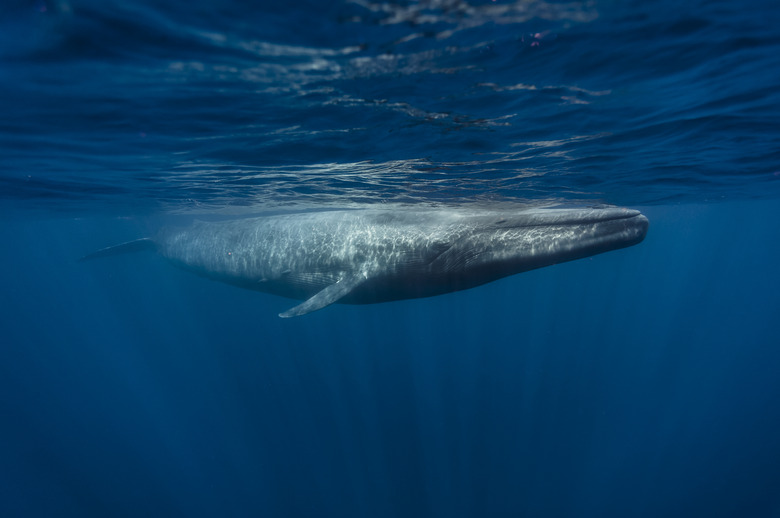Food Chain With Three Organisms That Include Humans
Food chains are made up of at least three parts: the producers that generate food from sunlight, such as most plants, the primary consumer level herbivores that eat plants and the subsequent levels of consumers that eat the herbivores. Mixed in are the omnivores that eat both plants and animals. A three-organism food chain that includes humans will have a producer, a primary consumer herbivore and the secondary human consumer.
TL;DR (Too Long; Didn't Read)
**TL;DR (Too Long; Didn't Read)**
Food chains are made up of producers, such as plants, which create food from sunlight; primary consumers or herbivores that eat plants; and secondary and higher level consumers that eat the herbivores or lower-level consumers. Omnivores such as humans eat plants and animals from all levels, but a food chain that includes humans has a producer, a primary consumer and humans.
How the Human Food Chain Works
How the Human Food Chain Works
Humans are said to be at the top of the food chain because they eat plants and animals of all kinds but are not eaten consistently by any animals. The human food chain starts with plants. Plants eaten by humans are called fruits and vegetables, and when they eat these plants, humans are primary consumers. Most humans also eat animals further up the food chain. Because they eat both plants and animals, humans are considered omnivores.
The typical human food chain has only thee or four organisms in it. Humans eat fruit and vegetable, herbivores and a few carnivores but don't consistently eat animals higher up the food chain. Most of the human diet consists of organisms near the lower end of the food chain even though humans are considered to be at the top.
Some Representative Food Chain Examples
Some Representative Food Chain Examples
Food chains are sometimes described as long chains reaching from tiny one-celled algae to high-level predators such as tigers, but that's not the way food chains work. Food chains must have at least three organisms and a lot of food chains don't have more than that. Many animals eat only producers or first-level consumers and few food chains include consumers that eat second and third level consumers.
For example, algae are producers that convert light into organic molecules, which plants and animals use as food. Krill are tiny crustaceans that eat algae. Whales such as the blue whale eat krill but they have no consistent predators. This blue whale food chain has only three organisms.
Lions are considered to be near the top of the food chain because they have no predators that consistently eat them. But lions eat grazing animals such as antelopes and antelopes eat grass, a producer. This lion food chain has only three organisms.
Longer food chains are not rare. For example, some birds eat worms, insects and slugs that eat plants. The birds are eaten by foxes, hawks and eagles. These food chains have at least four organisms. In the sea, crustaceans eat algae, which are producers. The crustaceans are eaten by fish which are eaten by seals. The seals are eaten by polar bears. The polar bear food chain has five organisms. You can find many other food chain examples of varying lengths with a little research.
Human Food Chains With Three Organisms
Human Food Chains With Three Organisms
Most human food chains have only three organisms because humans generally do not eat carnivores. While there are exceptions, especially for marine carnivores, most human food is plant-based or based on the consumption of herbivores.
For example, meat is a major food group for humans. Meat is usually beef, chicken, turkey or pork. These animals are all primarily herbivorous, and even if pigs are omnivores, for human consumption they are fed mostly plant material. As a result, the human food chain for meat is only three organisms long: plant producer, herbivore and human consumer.
For food harvested from the sea, the human food chains can be more complicated. A simple three-organism human food chain is made up of algae as the producer, shrimp as the primary consumer and humans as the secondary consumer. A longer food chain is that of humans eating tuna, which eat other fish that, in turn, may eat smaller fish until the smallest fish eat algae. While humans are omnivores, the food chains that include animals are mostly made up of three organisms with longer food chains possible as well.
Cite This Article
MLA
Markgraf, Bert. "Food Chain With Three Organisms That Include Humans" sciencing.com, https://www.sciencing.com/food-three-organisms-include-humans-8623651/. 22 November 2019.
APA
Markgraf, Bert. (2019, November 22). Food Chain With Three Organisms That Include Humans. sciencing.com. Retrieved from https://www.sciencing.com/food-three-organisms-include-humans-8623651/
Chicago
Markgraf, Bert. Food Chain With Three Organisms That Include Humans last modified March 24, 2022. https://www.sciencing.com/food-three-organisms-include-humans-8623651/
